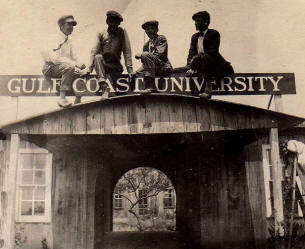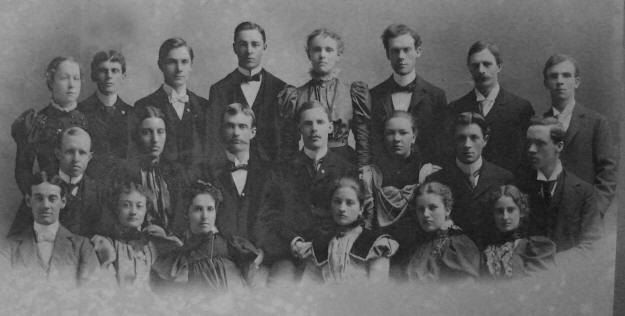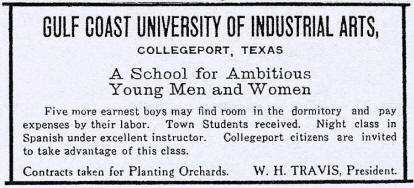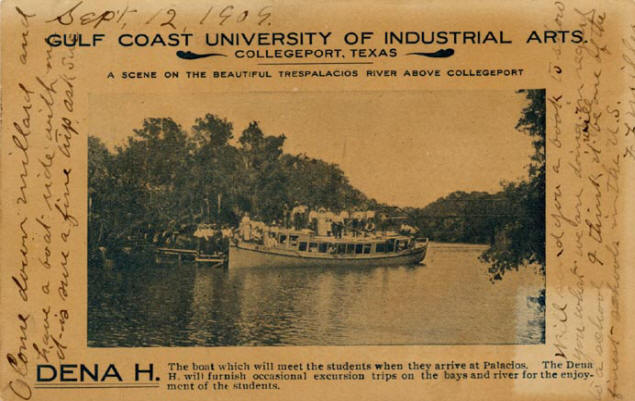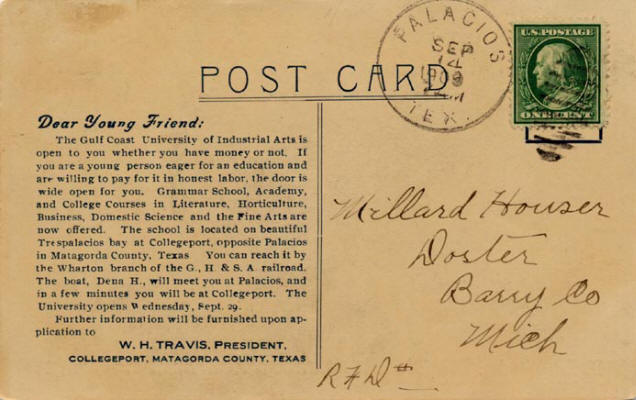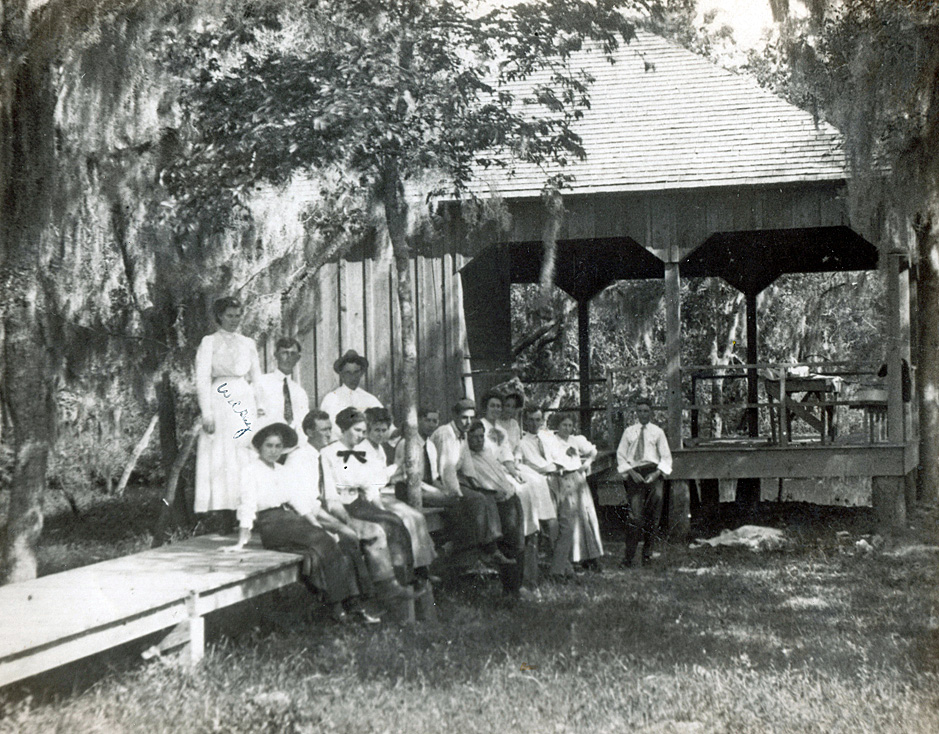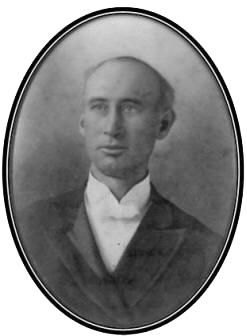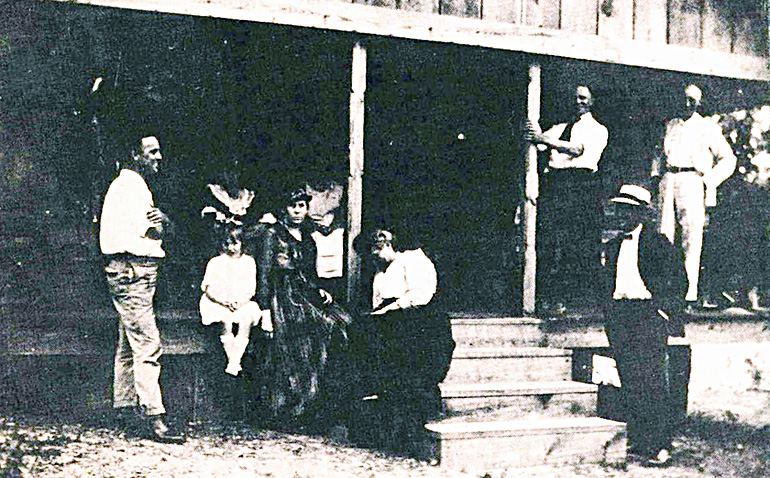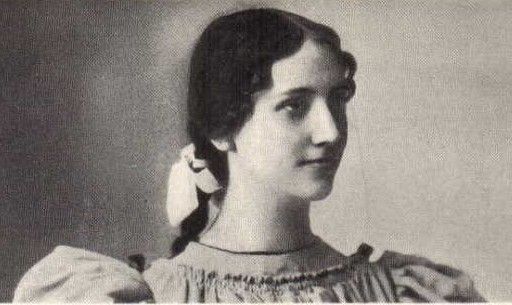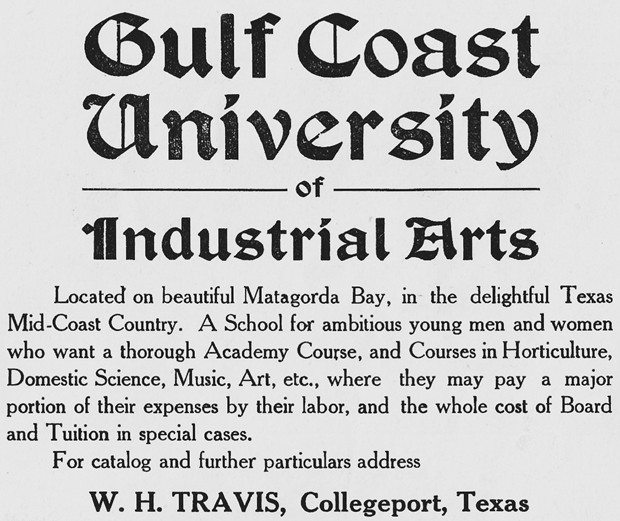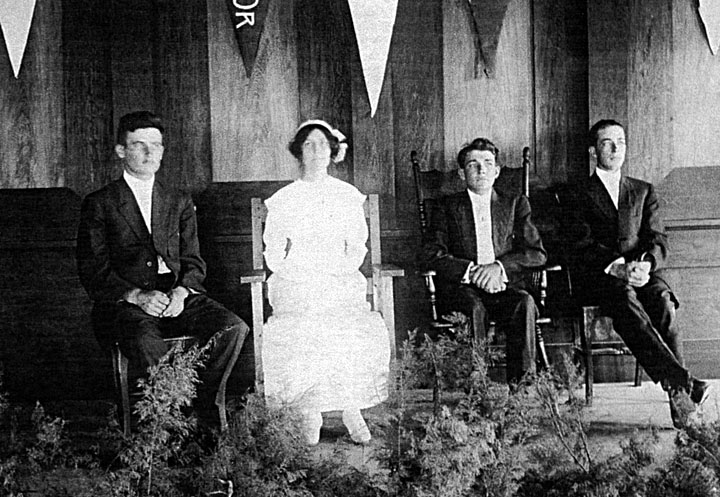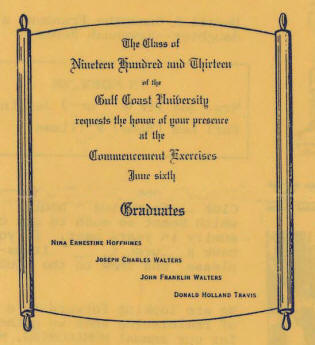|
Motto |
|
||||||||
|
|
|||||||||
|
|
|||||||||
|
|
|||||||||
|
|
|||||||||
|
|
|||||||||
|
Many years ago Prof. W. H. Travis decided that a school which would give a practical, industrial education would supply what he considered lacking in our present educational system, and the result is the establishment in Collegeport of what is known as the Gulf Coast University of Industrial Arts.
No subject at the present is
receiving larger attention than that of practical education. In the
Collegeport district the Gulf Coast University of Industrial Arts is
demonstrating that best practical education for boys and girls may
be had by them at the cost of earnest effort upon their part. The
effort to earn an education by their own hands is a great education
in itself.
The school has 350 acres of which
constitute the farm, nurseries, gardens and campus. It has already
collected dairy stock implements, teams and tools for work on these
grounds. It has a nursery stock valued at $6000. These things have
been accumulated, not from gifts, but from the results of labor
performed by the students under management of the instructors.
It is the purpose of the school to
keep the highest sane literary curriculum and at the same time fit
the boy and girl for immediate useful work the moment they graduate.
For instance, the boy will know how to manage a farm, or how to
direct a working force in such a way as to get the greatest cheerful
response from the force under his charge. He will be able to
construct buildings. He will be taught to successfully grapple with
the problem of supply and demand and the proper distribution of
products. In fact, his education will be intensely practical.
The girl will be trained in
household duties and economics by actual work in the kitchen,
laundry, dining room and parlors of the home. Her instruction in
literature, music and art will at the same time make her the best
social companion.
This school has been in successful
operation for three years, having graduated its first academic class
in June of this year. The school was the first to turn the virgin
soil and plant the first crop in the vicinity of Collegeport. It is
at present a vital force in locating and settling the very best
class of people in the community, for people seek a location where
such a school is in operation.
There are many people in the North
who desire a locality for removal from the rigid winters of those
States and provinces.
The school has seen this need and
has already solicited these people. It is now improving properties
for homes, for those who can not live here the whole year because of
their business interests in the north. The situation is thus unique.
The students are here whose services are readily had to care for the
grounds, through which services under the guidance of their teachers
a compensation for an education and at the same time the education
itself acquired. The student spends an average of six hours per day
for his literary and scientific instruction and four hours per day
for practice. While the practice is educational it is at the same
time equivalent to money paid for tuition and board.
Even the buildings of the school
will be built by student labor. The experience of the school
management is that the labor of the students is of the very highest
class, as each student is desirous of the very best results since
the results determine in a measure his class grades.
At the present time the school has
properties which it has placed upon the market. These properties are
being improved by planting a small orange orchard on each lot. Many
of these lots are already sold to Northern people. The students are
caring for these orchards for a term of years. The revenue from the
sale of these lots will be sufficient in amount to erect a number of
buildings for the school. This fact illustrates one way how the
purpose of the school to make itself self-supporting and
self-endowing is carried off. The farms, orchards, dairies, gardens,
nurseries, hotels, manufacturies, etc., will provide other means of
support and self-endowment.
One great fundamental teaching of
the school is that no student should look for any advantage in this
world without a just return on his part for what he receives. He is
also taught that there are plenty of resources in the earth to give
him an opportunity to become a public benefactor, and that he ought
not to look for advantages simply for self at the expense of
another. The spirit of "graft" is frowned upon in this school.
The much discussed
subject of what constitutes a true education is practically solved
in the method of instruction adopted by |
|||||||||
Misses Ida and Ola Bates have gone to Collegeport, where they have
entered the Gulf Coast University of Industrial Arts. Palacios
column, Houston Post, October 31, 1909 |
|||||||||
|
A Very Pleasant As Well As Instructive Program Gave a Fitting Finish to the First Year's Work The first year of the Gulf Coast University of Industrial Arts has passed into history. On May 24th the faculty, students and friends of the school celebrated the event in a manner that combined instruction with pleasure. At ten o'clock a fair sized audience assembled at the chapel for the closing exercises which were carried out entirely by the students of the various departments. The productions offered were naturally classed into a threefold division including the literary, horticultural and musical departments of the school. The literary department was represented by Mr. Esker Martin, who gave a history of the school and of the year, gleaning very successfully the striking and important events, and clarifying them for future reference. Miss Sarah Aucutt read an original poem entitled "The College of Collegeport," in which the young poetess displayed considerable ability both in observation of the peculiar characteristics of each teacher and student and the setting of the same in rhyme. Mr. Okla Sicks read a well prepared and interesting paper upon the theme "Athletics in School," in which he argued for a wise use of college sports as a means of benefit to the student and advertisement for the school. The prophecy was made by Vernon Hurd, who very cleverly portrayed the high place which the University will hold ten years from now, as well as the great success for each student. The various proclivities of the future leaders were very keenly observed and each one was pictured as doing honor to the school. The debate upon the question as to whether the Texan or Colonial struggle for independence had produced greater heroism was ably debated by Messrs. Donald Travis, William Moses, Fay Hurd and Joseph Walters. The merits of the debate compelled the judges to give their decision in favor of the Texas patriots as defenced by Messrs. Travis and Moses. The horticultural class was represented by Herman Kielhorn, Frank Walters and Joseph Payne, who gave papers of their own preparation as a result of their work in the department upon horticulture, agriculture and arbiculture. In another column we give papers on agriculture and horticulture which our readers will do well to peruse. It is our opinion that this class of product as a part of school exercises will appeal to our readers as a very practical and sensible departure from the ordinary school programs. Great credit is due Prof. Travis for his work in this line. The music department was well represented by a number of Junior students including Anna Van Ness, Kenneth House, Frank Travis, and Edith Soekland, while Evelyn Kone, Vernon Hurd and Paul Watanabe gave more difficult selections. The University is very fortunate to have Mrs. Amanda Van Ness as the head of the music department and her work is much appreciated, not only by the members of the University but by citizens of Collegeport. The exercises closed with a duet by Mrs. Van Ness and Mr. C. H. Harrington after which the Collegeport Military band played two selections. The class of work done by all was highly gratifying to those in charge of the work and many words of praise were heard from visitors. Instead of the banquet as announced in the catalogue for the evening, a boat ride and supper at Portsmouth Hotel was enjoyed and a large party took the trip. The day was fine and the ride, composed as it was a very pleasant one. Mr. and Mrs. O'Neil served a bountiful supper in their usual and generous and hearty way and many expressions of regret were heard from the guests that they must go from the table leaving so much of good things undevoured. The party arrived home quite well pleased with the day's doings. The Gulf Coast University has closed a good year as its first and the practical work done commends it to the citizens and strangers as worth of patronage and a credit to the community. The University will open again September 1st.
Collegeport Chronicle, Thursday, June 3,
1910 |
|||||||||
|
College Life Travis family members on the steps of the Gulf Coast University of
Industrial Arts which gave Collegeport the first half of its name.
William H. Travis at far right, Murray Alberton Travis standing on
the ground in front of William. Donald at far left, Eldon on the
porch holding the porch column, Libby and Rena sitting with young
Margaret. |
|||||||||
|
Agriculture is the art of cultivating all field crops, such as rice, peanuts, cotton, sugar cane, corn, alfalfa, clover and oats. The money crops of this coast country are rice, cotton, sugar cane, peanuts and corn. These have been tested and are positive to bring high prices. The possible crops are alfalfa, clover and oats. The rice industry is the most important field crop of this county. The cultivation of this crop is not unlike that of wheat, and in fact, many of the largest rice farmers of Texas came from Iowa and other wheat producing states. The only difference in the rice is the irrigation, rice being a semi-aquatic plant, and in order to secure the best results requires constant flooding during the growing season. A warm moist climate is essential. The land must be susceptible to good drainage and the subsoil must be near enough to the surface for the land to dry out in a few days after the water is turned off. The coast lands of Texas almost universally possess this characteristic. The plowing for rice is generally done in January, February and March. It can be done with the land wet or dry. If the land is too dry, water is applied to soften it. The plowing is generally very shallow and is done with gang plows often propelled by steam. The planting season is quite long during April, May and into June. About one barrel of seed to every three acres is used, water is turned on the field when the rice stalks are from six to eight inches high, usually about the first of June. The ground is submerged to a depth of about 6 inches for 70 to 90 days until the grain begins to open then the land is allowed to dry hard enough for the harvesting machines to work upon. Rice is generally threshed within 10 or 15 days after the harvest. This is similar to that of wheat and costs about the same. The rough rice is sold to the mills which remove the hull and polish it. It is estimated that one acre will produce ten barrels which is sold to the rice mills for $2.50 to $3.00 per barrel. The second largest agricultural industry of Texas is cotton. It is almost as necessary to the human family as bread. The uses for it are constantly growing in number, and the demand is increasing more rapidly than the world's population. Some cotton has been grown in Texas since the beginning of its Anglo-Saxon settlement. For many years it has been the leading crop of the state, and during most of those years it has been a very profitable and satisfactory crop. Cotton has been a profitable crop in Texas for several reasons. The conditions of climate and soil are especially adapted to it, and the plant under ordinary conditions is easily cultivated. It is practically a sure crop, there is never a total failure, even under the very unfavorable circumstances. The product is always marketable and can quickly be converted into cash. The average production of cotton on most of the land of Texas is one-half to one bale per acre and in some river bottom land as high as two bales an acre produced without irrigation. It is known that one bale of cotton will bring from $60 to $75. The growing of sugar cane is another very profitable industry of this country. The sugar cane is seeded by planting stalks and it produces four crops from one planting. The average production is twenty-five tons the first year, twenty-two tons the second, eighteen tons the third year and fifteen tons the fourth, making an average of twenty tons per acre for four years. The cost of planting and cultivating an acre in sugar cane averaged about $30, and cost of cutting and delivering about $12. The average price of the cane, which of course is governed by the price of the sugar, is $3 per ton; besides the sugar, the cane yields about five gallons of molasses per ton, which sells for sixty cents per gallon. With rice growing as its principal agricultural industry, and the crop a very attractive and satisfactory one which grown in moderation, Texas does not class as one of the great grain producing states, still it is a grain producing state, the production of cereals constituting an important factor in the scheme of diversification, now the vogue. Texas is second only to Louisiana in the production of rice, although rice growing according to modern methods is a brand new industry in the state, but a small percentage of the lands adapted to that cereal have yet been placed in cultivation. The quality of wheat, oats and corn sent out of Texas is exceptionally good. The crops come on the market several weeks in advance of those of other states, and they are always in good demand at prices somewhat above the figures paid similar produce of other states. Corn has been grown in Texas almost from the day permanent settlements were established upon its soil, but not until last year's supply did the yield become sufficient to supply the home demand. Wheat and oats have been grown in Texas for more than thirty years, but only within the past ten years have the crops been of considerable size.
The peanut as a forage and pasture plant is
rapidly and deservedly becoming popular with the Texas farmer. Being
a legume it exercises a highly beneficial effect on the soil and at
the same time furnishes a highly nitrogenous feed stuff, greatly
relished by stock as green food or as hay. Peanuts are partial to
loose soils of a light color. The land should be well drained and
not too rich in vegetable matter. Barnyard manure should be used
only in small quantities. Phosphoric acid and potash are the main
elements of plant food required by the peanut for best results. |
|||||||||
|
Horticulture treats of the cultivation of all garden products such as peas, celery, strawberries, potatoes, tomatoes, watermelons, cauliflower, beets, lettuce, etc. This part of the coast country is said to be the best for growing these vegetables in winter and summer as it does not get too hot nor too cold. The rainfall is about forty-two inches or the same as Illinois, and irrigation can be had if need be. The winter gardens bring the greatest profits because we can ship them up north where they have no fresh vegetables in winter. Celery is one of the most profitable crops to market except in summer and fall, when the northern people grow it themselves. To grow celery successfully the seed bed should be cultivated deep and fertilized heavily. The seed should be sown in rows about four inches apart. They should be sown thinly and covered. The land should be kept moist by keeping wet sacks over them until they show. For spring planting seed should be sown about the last of December in hot beds. The Golden Self Blanching is the best for this country. Two blanch boards should be placed, one on each side, so that no light can reach the plants. It is said that if celery is handled rightly if will bring about one thousand dollars net profit per acre. Cauliflower is the grandest vegetable of the coast country. The best seed should be selected, the Snowball being about the best. For the seed bed the land should be rich and well drained. The seed should be sown thinly and covered from one-half to three-fourths inches deep. The bed must be watered every day unless it rains. The seed should be sown about the first of August and six weeks later set out; about eight hundred pounds of fertilizer should be used to the acre. The land should be irrigated before or after transplanting if too dry. When the flowers appear tie the leaves up over the flower and they will be ready for shipment about Christmas time. Onions, beets and cabbages are other valuable crops of the Texas coast country. The strawberries, when grown in the coast country ripen from December until May, and are shipped north when they cannot be procured fresh from gardens, except from the southern country. The strawberries bring a profit from three hundred to seven hundred dollars per acre and will always be a very profitable crop to grow in this section. The growers of horticultural products are learning the great benefits to be derived from organization which guarantees the best results.
The story of horticulture as carried on in our
University will mean much in the future to this section of the coast
country. |
|||||||||
|
|||||||||
|
|
|||||||||
|
Rev. W. H. Travis, president of Gulf Coast University at Collegeport, Tex., is visiting his niece, Mrs. E. A. Valiant, at her home on Third avenue west. President Travis was formerly pastor of the Philadelphia Baptist church in St. Paul, but was obliged to go south ten years ago on account of his throat. He found an opportunity for educational work there, for he founded the Baptist college at Palacios, Tex., which is now a flourishing school, and three years ago started the Gulf Coast University of Industrial Arts of which he has been president since its founding. This school owns a tract of 40 acres on the gulf, and the courses consist of the literary, horticultural, domestic science and musical departments in the academy, the intention being to add the college courses later. The work there has already proved very successful.
The Courier, Waterloo, Iowa, August 26,
1911 |
|||||||||
|
The commencement exercises of the Gulf Coast University of Industrial Arts will be held at the First Church in Collegeport next Tuesday evening. This is the first graduating class of this new school, which number three, Misses Ora Dierlam and Winnie Turner and Mr. Charles Pine. --Palacios Beacon, June 7, 1912 Graduated in Texas.
Miss Winnie Turner, daughter of Mr. and Mrs. J.
W. Turner, formerly of this city, graduated with the first class of
the Gulf Coast University of Industrial Arts, at Collegeport, Texas,
on June 3rd. Miss Turner was a student of the Beaver City high
school until the removal of the family to Collegeport two years ago.
She had an excellent standing with her class here, and graduated in
Texas with the highest honors of her class, being chosen to deliver
the valedictory, taking for her subject "Beauty of Service." Of her
the Collegeport Chronicle says: "The beautiful ideas
projected in this oration could arise only in a beautiful character
void of human selfishness. She was excellent in her delivery and
reflected much credit to her parents, the class and the
institution."--The Times-Tribune, Beaver City, Nebraska, June
20, 1912 |
|||||||||
|
|||||||||
|
There was to be a college for white folks on an industrial plan somewhat after the Tuskegee idea. It was started in a large, temporary, one story shanty style building where teachers and pupils boarded, worked and studied together for two or three years, when it failed to be self-supporting and suspended operations. The institution was called the Gulf Coast University of Industrial Arts and included a thirty acre farm adjoining. This temporary college building, now being town down and not likely to be replaced, answers the question—why Collegeport?
Baraboo Weekly, March 19, 1914 |
|||||||||
|
Saint Jo, Nov. 12—Funeral services will be held at 4 p. m. Sunday in the Presbyterian Church here for Rev. Murray Alberton Travis, 74, pastor of the church five years. Rev. William Hodge of Lewisville, former pastor of the Methodist Church here, and Rev. Mr. Travis’ two sons, Rev. Hubert Travis of Forreston, Ellis County, and Rev. Frank Travis of Abilene, will officiate and burial will be in McAllen Cemetery at 4 p. m. Monday. Rev. Mr. Travis died at his home Thursday after suffering a heart attack. He was born in Ontario, Canada and preached his first sermon at the age of 17. After attending academies in Minnesota he received his B. D. degree from the University of Chicago and accepted his first pastorate in Hamilton, Minn, in 1891. Rev. Mr. Travis first came to Texas to join the faculty of old Gulf Coast University of Industrial Arts at Collegeport as dean and business manager. He also organized the interdenominational community church there and edited the Collegeport Chronicle. Rev. Mr. Travis was in YMCA work during World War I and later served as pastor of the Presbyterian Church at Kosse and community churches at Alamo and Rio Hondo before coming to Saint Jo in 1949. He was formerly a member of the executive committee of the National Council of Community Churches. He was married to his childhood sweetheart, Laurena Ellen Culp, in 1890 and she died in 1948. He is survived by his wife, Mrs. Beth Travis, whom he married in Joliet, Ill., in 1950; the two sons, and a daughter, Mrs. Carl Eddy of Alamo.
Fort Worth Star Telegram, November 13,
1954 |
|||||||||
|
By Annie Lee Shelton Wharton County Junior College is by no means the first college in the Gulf Coast Country, even though it is the first to survive. The Community of Collegeport, down on the bay in Matagorda County, was once the site of the Gulf Coast University—born in 1909—died in 1910 [1914]. Only the old-timer remember the university, which grew out of land development by northern real estate dealers who sought to make the Collegeport section a citrus growing area. For a while the land promoters were successful. They chose the wrong crops, however, not knowing that in due time the area would become rich in rice and cattle. Gulf Coast University was advertised in glowing terms to prospective students. Lessons were held in the mornings, and in the afternoons the boys worked in truck gardens and the girls worked in community homes. “I remember where the building stood,” Mrs. Hattie Kundinger, resident of Collegeport for 40 years, says. "William Travis was the teacher, and his brother, Murray Travis, was pastor of the Collegeport Federated Church, and editor of the Collegeport Chronicle. There were three hotels, each catering to the tourist trade and prospective land buyers; two hardware stores, lumber yard, drug store, and many other business houses. Hugo Kundinger came to Collegeport in 1916 from Illinois, and has owned the Collegeport Drug Store, which he and Mrs. Kundinger operate, since 1917. "Those really were the days,” Mrs. Kundinger said. "We used to have a barge to Palacios to ship our fine watermelons out over the state. That was before we had a railroad. We also had a boat service to Palacios. A round trip ticket cost 25 cents. "I remember July 4, 1909, the entire town boarded the Dena H an excursion boat, and spent the day at the peninsula. Some history of the community can be gleaned from news stories in a June, 1911 issue of the Collegeport Chronicle, which Mr. Kundinger has preserved. One news story reveals that the late tourist party from Morris, Illinois, who visited our state recently, took only lemonade at the bars in Fort Worth, Houston, and Galveston.” After a visit over neighboring counties which the editor described as “like a trip through a wonderland of cotton, alfalfa, potatoes, and onions,” the editor also said that he found out "marvelous facts about the Texas coastal rain belt,” and that it is the "best corn country on earth.”
The Pierce Estate, he wrote, “has many fine thoroughbred cattle and
hogs, and the herd of Brahma cows and Poland China hogs have
attracted national attention.” Today there is a community of 200 persons at Collegeport. The town is scattered. Part of its homes and the elementary school are at the original site of the Gulf Coast University and town hotels and business firms.
Palacios Beacon,
July 14, 1949 |
|||||||||
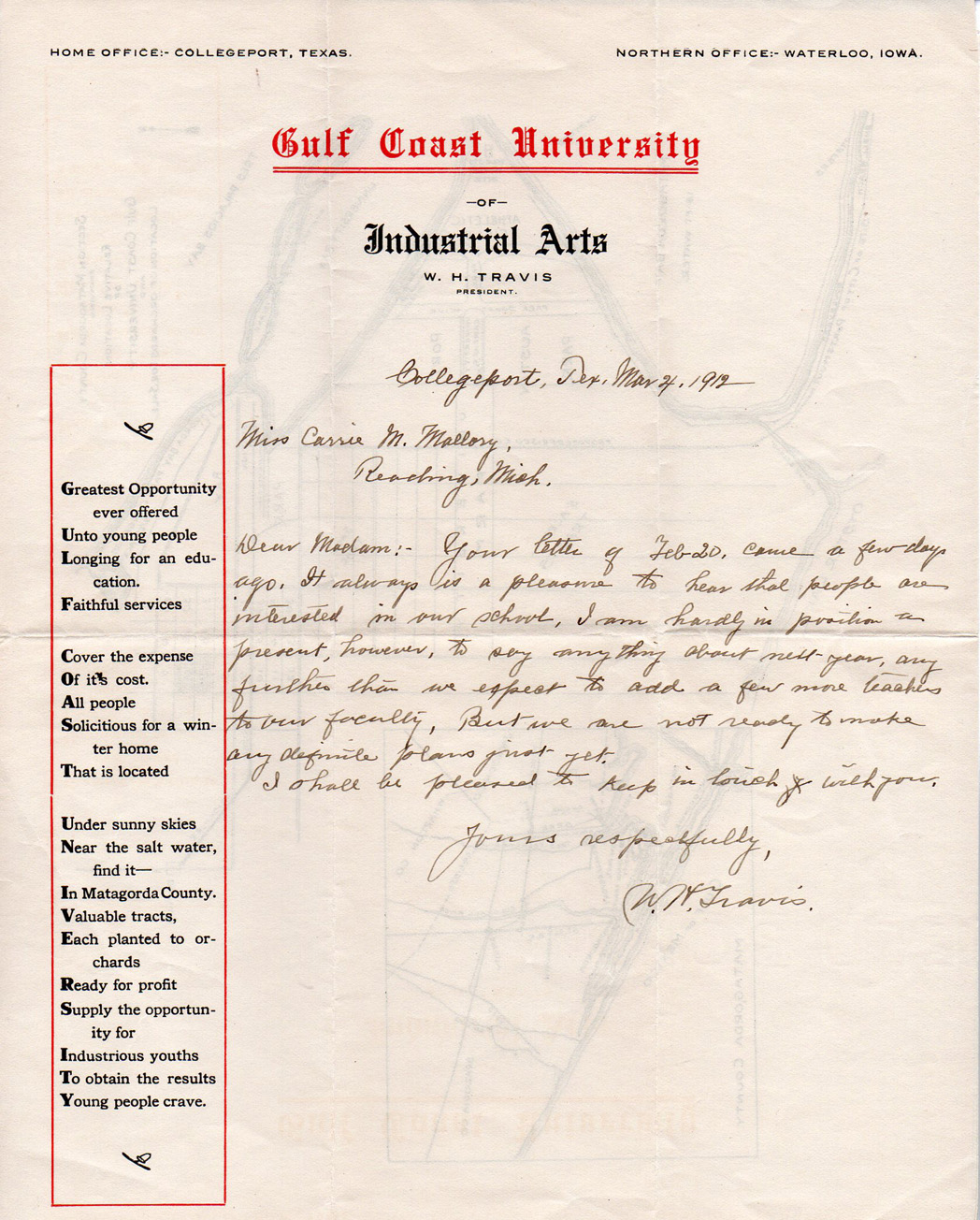 |
|||||||||
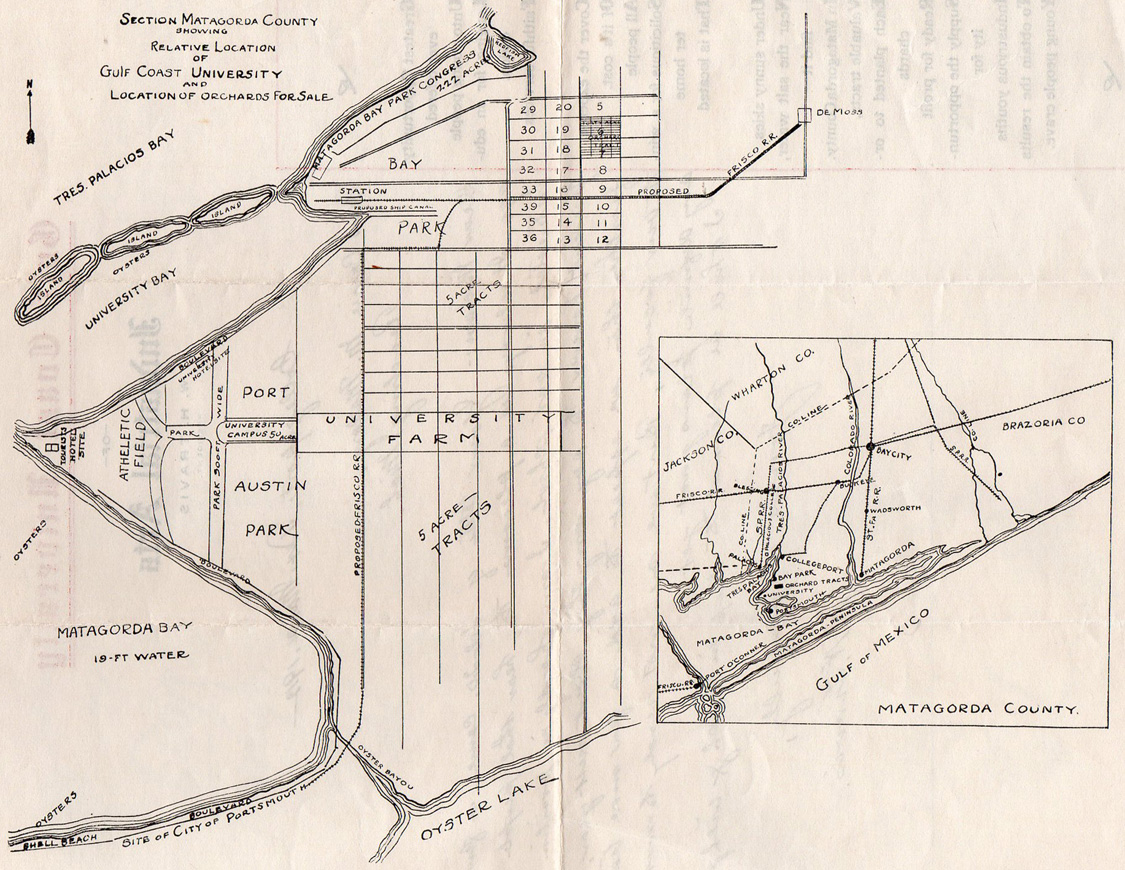 Map of proposed Gulf Coast University of Industrial Arts campus - This map was printed on the reverse side of the the GCU letterhead. |
|||||||||
